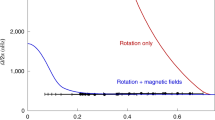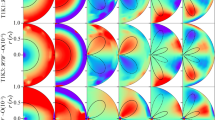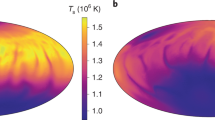Abstract
IT is possible to achieve low solar neutrino fluxes with solar models with rapidly rotating cores1–3. But to achieve a flux consistent with the 1 SNU (1 SNU = 10−36 neutrino capture per (target atom s−1) upper limit of Davis4, the rotation must be so rapid that the approximate treatment of rotation used is of doubtful validity. Further it is difficult to obtain a result simultaneously giving a flux less than 1 SNU and a solar oblateness consistent with observation5. Sakurai6 has shown that it is possible for Eddington–Sweet circulation to transfer angular momentum both inwards and outwards in solar models with rotating cores on a time scale much less than the solar lifetime. Thus as the Sun evolves, its rotating core gets smaller while its outer part spins up. This suggestion has led us to investigate the possibility that this spin-up might lead to the onset of some transient phenomenon, such as the sudden beginning of thermal convection. Under special circumstances, a transient state can lead to temporarily depressed neutrino fluxes7–10. It was hoped that the transient phase induced by spin-up, coupled with an already depressed flux due to the rotating core would lead to a flux of less than 1 SNU while requiring less extreme transients or rotation than is necessary when these effects are applied separately. In addition, a mechanism for the transient would be provided. Unfortunately this hope has not been realised and additional problems with rotating solar models have been discovered.
This is a preview of subscription content, access via your institution
Access options
Subscribe to this journal
Receive 51 print issues and online access
$199.00 per year
only $3.90 per issue
Buy this article
- Purchase on Springer Link
- Instant access to full article PDF
Prices may be subject to local taxes which are calculated during checkout
Similar content being viewed by others
References
Demarque, P., Mengel, J., and Sweigart, A., Astrophys. J., 183, 997 (1973).
Demarque, P., Mengel, J., and Sweigart, A., Nature phys. Sci., 246, 33 (1973).
Roxburgh, I., Nature, 248, 209 (1974).
Davis, R., jun., Bull. Am. phys. Soc., 17, 527 (1972).
Dicke, R. H., and Goldenberg, M., Phys. Rev. Lett., 18, 313, (1967)
Sakurai, T., Publ. astr. Soc. Japan, 24, 153 (1972).
Dilke, R. W. W., and Gough, D. O., Nature, 240, 262 (1972).
Rood, R. T., Nature phys. Sci., 240, 178 (1972).
Fowler, W. A., Nature, 238, 24 (1972), 242, 424 (1973).
Ezer, D., and Cameron, A. G. W., Nature phys. Sci., 240, 180 (1972).
Goldreich, P., and Schubert, G., Astrophys. J., 154, 1005 (1968).
Ulrich, R. K., Astrophys. J., 188, 369 (1974).
Hall, D. N. B., Astrophys. J. (in the press).
Johnson, H. L., Astrophys. J., 116, 640 (1952).
Author information
Authors and Affiliations
Rights and permissions
About this article
Cite this article
ROOD, R., ULRICH, R. Solar models with rotating cores. Nature 252, 366–368 (1974). https://doi.org/10.1038/252366a0
Received:
Issue Date:
DOI: https://doi.org/10.1038/252366a0
This article is cited by
-
Solar neutrinos: Theory versus observation
Space Science Reviews (1979)
-
Chemistry of the solar neutrino problem
Nature (1975)
-
Oblateness of solar models with rotating cores
Nature (1974)
Comments
By submitting a comment you agree to abide by our Terms and Community Guidelines. If you find something abusive or that does not comply with our terms or guidelines please flag it as inappropriate.



